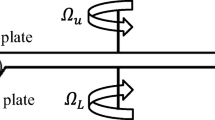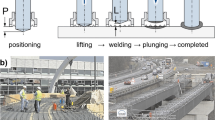Abstract
In this study, residual stresses of cold-forged ball studs were investigated by the contour method with using widely available wire-Electro-Discharging Machine (wire-EDM) and Coordinate Measuring Machine (CMM). After the wire-EDM cutting, one of the steps of the contour method, it was revealed that the surface contour data was affected from the cutting step. Therefore, to increase the accuracy of the measured residual stresses, one of the ball studs were heat-treated to normalize residual stresses due to cold forging. The contour data of the heat-treated sample was subtracted from the as-forged surface contour to eliminate any cutting-induced artefacts. The final residual stress profiles suggested that the subtracting procedure minimized the cutting errors. In addition, a new classification approach for the cutting-induced errors for the contour method was introduced. According to final stress maps obtained by the contour method, it was revealed that high compressive residual stresses were obtained at the socket regions of the ball studs, as expected. Balancing tensile residual stresses were observed at the inner regions.











Similar content being viewed by others
References
Yurtdaş S, Toparli MB, Damla T, Tanrıkulu B, Kılınçdemir E, İnce U, Aydın L (2018) A comparative study of metal shaping processes between forging and machining. In: Arapgirlioglu H, Atik A, Hiziroglu S, Elliott R, Atik D (eds) The most recent studies in science and art, vol 2. Gece Publishing, Ankara, pp 1462–1471
Prime MB, Gonzales AR (2000) The contour method: Simple 2-D mapping of residual stresses. In: Webster GA (ed) Sixth international conference on residual stresses. Maney Publishing, Oxford, pp 617–624
Kartal ME, Turski M, Johnson G, Fitzpatrick ME, Gungor S, Withers PJ, Edwards L (2006) Residual stress measurements in single and multi-pass groove weld specimens using neutron diffraction and the contour method. Mater Sci Forum 524–525:671–676
Evans A, Johnson G, King A, Withers PJ (2007) Characterization of laser peening residual stresses in Al 7075 by synchrotron diffraction and the contour method. J Neutron Res 15(2):147–154
Zhang Y, Ganguly S, Edwards L, Fitzpatrick ME (2004) Cross-sectional mapping of residual stresses in a VPPA weld using the contour method. Acta Mater 52(17):5225–5232
Pagliaro P, Prime M, Swenson H, Zuccarello B (2010) Measuring multiple residual-stress components using the contour method and multiple cuts. Exp Mech 50(2):187–194. https://doi.org/10.1007/s11340-009-9280-3
Toparli MB, Fitzpatrick ME, Gungor S (2015) Determination of multiple near-surface residual stress components in laser peened aluminum alloy via the contour method. Metall and Mater Trans A 46(9):4268–4275. https://doi.org/10.1007/s11661-015-3026-x
Hosseinzadeh F, Toparli MB, Bouchard PJ (2012) Slitting and contour method residual stress measurements in an edge welded beam. J Pressure Vessel Technol 134:0114021–0114026
Bueckner HF (1958) The propagation of cracks and the energy of elastic deformation. Trans Am Soc Mech Eng 80:1225–1230
Kartal ME (2013) Analytical solutions for determining residual stresses in two-dimensional domains using the contour method. Proc R Soc A Math Phys Eng Sci 469(2159):20130367. https://doi.org/10.1098/rspa.2013.0367
Toparli MB, Fitzpatrick ME, Gungor S (2013) Improvement of the contour method for measurement of near-surface residual stresses from laser peening. Exp Mech 53(9):1705–1718. https://doi.org/10.1007/s11340-013-9766-x
Bouchard P, Ledgard P, Hiller S, Hosseinzadeh F (2012) Making The Cut for The Contour Method. Paper presented at the 15th International Conference on Experimental Mechanics (ICEM 2015), Porto, Portugal
Prime MB, Kastengren AL (2011) The contour method cutting assumption: error minimization and correction. In: Proulx T (ed) Experimental and applied mechanics, volume 6. Conference proceedings of the society for experimental mechanics series. Springer New York, pp 233–250. https://doi.org/10.1007/978-1-4419-9792-0_40
Hosseinzadeh F, Kowal J, Bouchard P (2014) Towards good practice guidelines for the contour method of residual stress measurement. J Eng 8:453–468. https://doi.org/10.1049/joe.2014.0134
Ahmad B, Fitzpatrick ME (2016) Minimization and mitigation of wire EDM cutting errors in the application of the contour method of residual stress measurement. Metall and Mater Trans A 47(1):301–313. https://doi.org/10.1007/s11661-015-3231-7
Muránsky O, Hamelin CJ, Hosseinzadeh F, Prime MB (2018) Evaluation of a self-equilibrium cutting strategy for the contour method of residual stress measurement. Int J Press Vessels Pip 164:22–31. https://doi.org/10.1016/j.ijpvp.2017.04.002
Toparli MB, Fitzpatrick ME (2016) Development and application of the contour method to determine the residual stresses in thin laser-peened aluminium alloy plates. Exp Mech 56(2):323–330. https://doi.org/10.1007/s11340-015-0100-7
DeWald AT, Hill MR (2009) Eigenstrain-based model for prediction of laser peening residual stresses in arbitrary three-dimensional bodies Part 2: Model verification. J Strain Anal Eng Des 44(1):13–27. https://doi.org/10.1243/03093247jsa420
Pagliaro P, Prime MB, Clausen B, Lovato ML, Zuccarello B (2009) Known residual stress specimens using opposed indentation. J Eng Mater Technol 131 (3). https://doi.org/10.1115/1.3120386
Hill MR, Olson MD (2014) Repeatability of the contour method for residual stress measurement. In: Rossi M et al (eds) Residual stress, thermomechanics & infrared imaging, hybrid techniques and inverse problems, vol 8. Conference proceedings of the society for experimental mechanics series. Springer, Cham. https://doi.org/10.1007/978-3-319-00876-9_13
DIN EN 10263-4: Steel rod, bars and wire for cold heading and cold extrusion - Part 4: technical delivery conditions for steels for quenching and tempering. German Institute for Standardization (DIN)
Stress Relief of Steel Parts AMS2759/11A (2018). SAE International
The Contour Method (2013). In: Practical Residual Stress Measurement Methods. pp 109–138. https://doi.org/10.1002/9781118402832.ch5
Prime MB, Kastengren AL (2011) The contour method cutting assumption: error minimization and correction. In: Proulx T (ed) Experimental and applied mechanics, vol 6. Conference proceedings of the society for experimental mechanics series. Springer, New York. https://doi.org/10.1007/978-1-4419-9792-0_40
Schajer GS, Prime MB (2006) Use of Inverse Solutions for Residual Stress Measurements. J Eng Mater Technol 128(3):375–382
Toparli MB, Fitzpatrick ME (2011) Residual stresses induced by laser peening of thin aluminium plates. Mater Sci Forum 681:504–509. https://doi.org/10.4028/www.scientific.net/MSF.681.504
DeWald A, Hill M (2006) Multi-axial contour method for mapping residual stresses in continuously processed bodies. Exp Mech 46(4):473–490
Kartal ME, Liljedahl CDM, Gungor S, Edwards L, Fitzpatrick ME (2008) Determination of the profile of the complete residual stress tensor in a VPPA weld using the multi-axial contour method. Acta Mater 56(16):4417–4428
Prime MB, Newborn MA, Balog JA (2003) Quenching and cold-work residual stresses in aluminum hand forgings: contour method measurement and FEM prediction. Mater Sci Forum 426–432:435–440
Pagliaro P, Prime M, Robinson JS, Clausen B, Swenson H, Steinzig M, Zuccarello B (2011) Measuring inaccessible residual stresses using multiple methods and superposition. Exp Mech 51(7):1123–1134. https://doi.org/10.1007/s11340-010-9424-5
Ahmad B, Fitzpatrick ME (2015) Effect of ultrasonic peening and accelerated corrosion exposure on the residual stress distribution in welded marine steel. Metall and Mater Trans A 46(3):1214–1226. https://doi.org/10.1007/s11661-014-2713-3
Araujo de Oliveira J, Fitzpatrick ME, Kowal J (2014) Residual stress measurements on a metal matrix composite using the contour method with brittle fracture. Adv Mater Res 996:349–354. https://doi.org/10.4028/www.scientific.net/AMR.996.349
Zabeen S, Preuss M, Withers PJ (2013) Residual stresses caused by head-on and 45° foreign object damage for a laser shock peened Ti–6Al–4V alloy aerofoil. Mater Sci Eng A 560:518–527. https://doi.org/10.1016/j.msea.2012.09.097
Xie P, Zhao H, Wu B, Gong S (2015) Evaluation of residual stresses relaxation by post weld heat treatment using contour method and X-ray diffraction method. Exp Mech 55(7):1329–1337. https://doi.org/10.1007/s11340-015-0040-2
DeWald AT, Hill MR (2009) Eigenstrain-based model for prediction of laser peening residual stresses in arbitrary three-dimensional bodies Part 1: Model description. J Strain Anal Eng Des 44(1):1–11. https://doi.org/10.1243/03093247jsa417
Olson MD, DeWald AT, Prime MB, Hill MR (2015) Estimation of uncertainty for contour method residual stress measurements. Exp Mech 55(3):577–585. https://doi.org/10.1007/s11340-014-9971-2
Traoré Y, Hosseinzadeh F, Bouchard PJ (2014) Plasticity in the contour method of residual stress measurement. Adv Mater Res 996:337–342. https://doi.org/10.4028/www.scientific.net/AMR.996.337
Kaiser R, Stefenelli M, Hatzenbichler T, Antretter T, Hofmann M, Keckes J, Buchmayr B (2015) Experimental characterization and modelling of triaxial residual stresses in straightened railway rails. J Strain Anal Eng Des 50(3):190–198. https://doi.org/10.1177/0309324714560040
The Contour Method. In: Practical Residual Stress Measurement Methods. pp 109–138. https://doi.org/10.1002/9781118402832.ch5
Acknowledgements
The authors would like to thank to CMS R&D Center, Turkey for their cooperation.
Author information
Authors and Affiliations
Corresponding author
Ethics declarations
Conflict of Interest
On behalf of all authors, the corresponding author states that there is no conflict of interest.
Additional information
Publisher’s Note
Springer Nature remains neutral with regard to jurisdictional claims in published maps and institutional affiliations.
Rights and permissions
About this article
Cite this article
Toparli, M., Kılınçdemir, N., Yurtdaş, S. et al. Residual Stress Measurements of Cold-Forged Ball Studs by the Contour Method. Exp Tech 46, 919–930 (2022). https://doi.org/10.1007/s40799-021-00521-w
Received:
Accepted:
Published:
Issue Date:
DOI: https://doi.org/10.1007/s40799-021-00521-w




